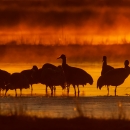About Us
About the Refuge
Alamosa National Wildlife Refuge was established in 1963 to provide food, cover, and breeding habitat for migratory birds and resident wildlife. The Refuge conserves and enhances the mixtures of wetland and desert habitats found in the area to accomplish these goals. Habitat management tools used on the Refuge include water and wetland management, weed control, haying, grazing, and prescribed fire. The 12,026 acre Refuge is located at the south end of the San Luis Valley, a high mountain basin in south-central Colorado. It’s one of three national wildlife refuges in the Valley that provide crucial feeding, resting, and breeding habitat for over 200 bird species and other wildlife. The San Luis Valley, sitting at 7,800 feet, extends over 100 miles from north to south and 50 miles from east to west. Three mountain ranges surround it – the Sangre de Christo to the east, the San Juan to the west, and the Saguache to the north. At sunset, the high peaks of the Sangre de Christo take on the blood red glow which inspired the Spanish explorers to name the range “Blood of Christ.” The surrounding mountains feed the arid valley with precious surface water and replenish an underground reservoir. The mountain snow melt and artesian wells provide needed water to the agricultural community and to the rivers, creeks, and wetlands that thread across the valley floor. The Refuge lies within the Rio Grande floodplain and consists of wet meadows, old river oxbows, riparian riparian
Definition of riparian habitat or riparian areas.
Learn more about riparian corridors, and dry uplands. These diverse habitats support a multitude of songbirds, water birds, waterfowl, raptors, mule deer, beavers, and coyotes. The west side of the Refuge borders the Rio Grande, long considered to be the life blood of the San Luis Valley. Water from the Rio Grande maintain these important habitats. Mallards, pintails, teals, and Canada geese are common, as are American avocets, killdeers, white-faced ibises, egrets, and herons.
Our Mission
Vision Statement
The San Luis Valley National Wildlife Refuge Complex, set in a high expansive desert valley, is cradled between the snowcapped peaks of the San Juan and Sangre de Cristo Ranges. Mountain snowmelt feeds the Rio Grande, numerous streams, and a dynamic ground water system creating a diverse mix of playas, wet meadows, and willow and cottonwood riparian riparian
Definition of riparian habitat or riparian areas.
Learn more about riparian corridors that are in stark contrast with the surrounding arid landscape. As reflected by 12,000 years of human history in the valley, the refuge complex attracts many people. Visitors experience the ancient song of the sandhill crane, witness evening flights of thousands of waterfowl, and listen to bugling elk. Through ever changing conditions like climate change climate change
Climate change includes both global warming driven by human-induced emissions of greenhouse gases and the resulting large-scale shifts in weather patterns. Though there have been previous periods of climatic change, since the mid-20th century humans have had an unprecedented impact on Earth's climate system and caused change on a global scale.
Learn more about climate change , the refuges support and foster a collaborative spirit between their neighbors and partners to conserve the valley’s treasured resources.
Our History
The Migratory Bird Conservation Commission approved the establishment of Alamosa National Wildlife Refuge on June 27, 1962. The Colorado Game, Fish and Parks Commission approved the Refuge on May 4, 1962. The Refuge was officially established on July 25, 1963, with the signing of the deed for the first parcel. On December 1, 1965, about 86 acres administered by Bureau of Land Management were withdrawn from the public domain through Public Land Order 3899. Also in 1965, the approved acreage was enlarged to about 10,291 acres. The acquisition of several other parcels, such as the former Lillpop property, brought the Refuge to its current size of approximately 12,026 acres. Of this, 816 acres were acquired by another Federal agency, 10,905 acres were purchased by the U.S. Fish and Wildlife Service, and 219 acres were donated.
Other Facilities in this Complex
About the Complex
Alamosa, Monte Vista, and Baca National Wildlife Refuges are areas set aside for migratory birds and resident wildlife. The Refuges are now combined administratively into the San Luis Valley National Wildlife Refuge Complex. The 12,026 acre Alamosa Refuge includes wetland areas, riparian riparian
Definition of riparian habitat or riparian areas.
Learn more about riparian corridors, wet meadows, and river oxbows. The wetland and river habitats provide a wildlife oasis in this dry region. These habitats support a variety of wildlife, including songbirds, water birds, raptors, deer, beavers, coyotes, and more. The artificially created wetlands on the 14,804 acre Monte Vista Refuge are intensively managed to provide habitat for a wide variety of waterfowl and other water birds. Mallards, pintails, teals, and Canada geese are common, as are American avocets, killdeers, white-faced ibises, egrets, and herons. Irrigation canals and wells provide precious water to maintain this important wetland habitat. The 92,500 acre Baca Refuge is a highly diverse combination of shrublands, grasslands, wet meadows, playa wetlands, and riparian areas. This Refuge was set aside not only as another haven for migratory birds and resident wildlife, but also as an important piece in a broader conservation effort to protect the wildlife, habitat, and water of the north and east portions of the San Luis Valley. These three refuges of the San Luis Valley National Wildlife Refuge Complex contribute to over 560 refuges in the National Wildlife Refuge System – a network of lands set aside and managed by the U.S. Fish and Wildlife Service specifically for wildlife. The National Wildlife Refuge System is a living heritage, conserving wildlife and habitat for people today and generations to come.


